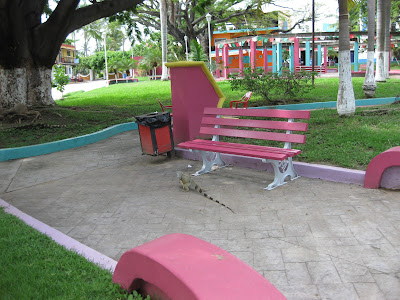A short drive northwest around the bay takes you to a small town with a large marina called La Cruz de Huanacaxtle. The town derives its name from the huanacaxtle trees that dominate the plaza. The tree’s name comes from the Nahuatl nacaztli, meaning ear. The fruits are shaped somewhat like an elephant’s ear (in English one name for the tree is ear-pod tree). A cross made of huanacaxtle wood stands in a circular plaza between the highway and the main plaza.
 |
| A huanacaxtle tree in the plaza of La Cruz |
La Cruz has a salón ejidal, meaning that the town was granted communal agricultural land under the agrarian reform programmes that began after the Mexican Revolution ended in 1920. While this gave land to landless peasant farmers, the land was not always of good quality. Ejidos were not a guarantee of prosperity, but they did lift some rural families out of the worst poverty. However, the business of La Cruz is no longer agriculture, but tourism which shapes the economy and layout of the town.
 |
| The cross of la Cruz |
The main road that takes traffic to the exclusive and expensive resorts of Punta de Mita is lined by businesses: inexpensive restaurants catering to the tastes and budgets of locals, grocery (abarrotes) shops, hardware and spare parts suppliers and the like. On the hills above the town are condominiums, villas and hotels positioned to have a prime view of the bay. Turn left, as usual from the right-hand lateral lane, off the main road and one of the few paved streets in La Cruz takes you past the wooden cross to the plaza. Trees cast a pleasant shade on the gardens, with the inevitable kiosko in the centre. On the morning we visited, an iguana was the only other creature enjoying the gardens. A small, simple concrete church occupies one corner just past the public toilets, there are four or five restaurants/cafés and the inevitable pharmacy. At a small café an attentive and courteous young Mexican woman served us delicious coffee and French toast with plenty of fruit for 300 pesos (£15/$20).
 |
| An iguana goes for a stroll |
 |
| Iguanas are not the only animals in La Cruz. The marina saw no reason to post a sign in Spanish and English, presumably because very few Mexicans enter. |
La Cruz, in short, is a very ordinary Mexican small working-class town. However, cross the plaza and one enters another world. The waterfront is occupied entirely by a huge marina, protected by a barrier operated by a languid guard. The yachts and other boats are too many to count, but they alone must exceed many times the combined wealth of all the Mexican residents of la Cruz. As we reached the yacht club building, three buses arrived with foreign tourists all booked in for one of the many excursions on the bay. The buses parked on grass beyond which was a roped off area prominently signposted propriedad privada. Through the trees we glimpsed the sun loungers of a hotel.
 |
| The marina of La Cruz. In the distance are the condominiums and hotels on the other side of the highway. |
A short walk from the marina entrance is the boatyard in which sat a huge yacht worthy of a middle ranking billionaire, the international sailing school and the fish market, where we bought some red snapper and prawns for dinner. A young woman was preparing a delivery of dorado and other fish plunged into ice on the back of her motorbike and then covered in black bin bags.
 |
| Dorado ready for delivery. |
I have rather mixed feelings about La Cruz, sandwiched between luxury accommodation built for foreigners and a waterfront occupied entirely for the pleasure of more foreigners. The ejido was never the rural idyll of justice and equality portrayed in the rhetoric of governments that descended from the Revolution. The ejido provided a perfect springboard with a ready-made following for an ambitious leader (comisario) to launch a political career, which was often accomplished with violence and corruption. Ejidos were often the place where land disputes or personal animosities were resolved with violence. But nevertheless, they did give a lot of rural people land. And four or five decades ago La Cruz would have been a tiny fishing/agricultural village, remote from the attentions of national and regional politicians. I don’t know what land or other property the ejido of contemporary La Cruz controls, but since tourism arrived the town has been shaped not so much by its people as by foreigners whose money has commandeered the most desirable parts and left the Mexicans in the middle. The same applies to Bucerías where we rent our apartment, and thus contribute in small way to the reshaping of the town by moneyed interests, but here at least, the beach remains open to Mexican and non-Mexican alike.
No comments:
Post a Comment